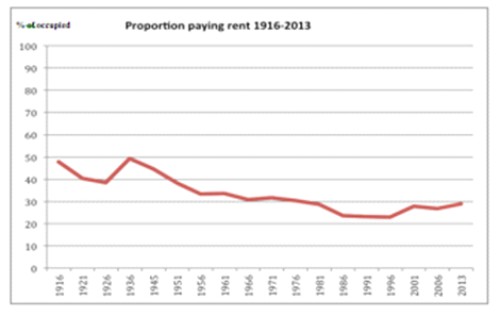At first sight, Census 2013 data suggest that home-ownership rates have fallen substantially since a peak in 1991. The most recent comments follow the release by Statistics New Zealand of home-ownership rates by individuals:
“The data on home ownership by individuals showed that the percentage who owned their home fell to just under half. In 2013, 49.8 per cent of people aged 15 years and over owned or partly owned the home they lived in, compared with 53.2 per cent in 2006.” (Statistics New Zealand, 2014)
As an aside, not too much can be read into ownership rates by individuals, especially a number that suggests that fewer than half of all New Zealanders now own a home. Homes are owned by households, not by individuals and that reduces the significance of any analysis by age groups or ethnicity. Census 2013 tells us that about 60% of households seemingly owned their homes. That’s a less dramatic number than 49.8%.
There is however a more significant problem with the data on home-ownership. There are too many gaps in the questions asked in the 2013 Census (and earlier equivalent questions) for us to be certain about any recent trends in home-ownership rates. The gaps mean we have no ownership information for about 362,000 of all dwellings; that’s 20.7% of all 1.76 million dwellings on Census night in 2013.
There are two main holes in the data. First, we have no information about who owns the 185,000 dwellings that were unoccupied on Census night (10.6% of all dwellings). Neither do we know why they were unoccupied. They might be holiday homes, between tenants, on the market, under renovation or the usual occupiers (owners or renters) may have been away on holiday or on business. We just don’t know.
The other major hole is the occupiers who didn’t answer the question or who gave an unclear answer. That was another 177,000 dwellings or 10.1% of all dwellings.
The data gaps seem to be growing – the 2013 gap (20.7%) was 19.4% in 2006. Part of that is probably caused by the rise in family trust ownerships, though the Census questions tried to capture these. Gaps in the questions also contributed.
If we turn the examination around and try to deduce home-ownership rates from the proportions of occupiers who pay rent, a different picture emerges. There were also gaps in renters’ data but 28.8% of all occupied dwellings (453,100) specified the weekly rent paid. We can probably assume that these rent-payers were arms-length occupiers, in other words, not connected to family trust ownerships where the occupiers might be nominal tenants.
‘Rent payers’ were 49.3% of occupants in the 1936 Census – the proportion has fallen significantly over the 77 years to 2013.
Of more recent note is that the proportion of ‘rent-payers’ has been relatively flat over the 30 years 1976-2013, as the chart shows:
It seems difficult to construct a story about falling home-ownership rates from this chart. If they really were falling, we should expect rising, rather than relatively flat rent-paying occupancy rates over the 37 years between 1976 and 2013. Rent-payers were 30.3% of occupied dwellings in 1976. In 2013, 28.8% of all occupiers were paying rent to the owner.
The Census questions must change if we want to understand the tenure of occupied dwellings and the status of unoccupied dwellings.
Statistics New Zealand has tried since 1996 to understand the impact of family trusts on housing tenure. Uncertainty about the influence of family trusts on ownership statistics has grown over the 17 years to 2013. We do know that the number of dwellings affected by family trust ownership grew by at least 28% in the seven years to 2013 (to 13.7% of all occupied dwellings).
The home-owning proportion of the population may have fallen since the 1991 Census. However, given the gaps in the data, a more reliable indicator of tenure trends may be the proportion of occupiers who are paying an identified amount of rent rather than the so-called ‘owners’. That proportion of rent-payers hasn’t changed much in the last 50 years.
We cannot draw any particular conclusion about home-ownership trends from Census data.
This article was first published in the Dominion Post.


